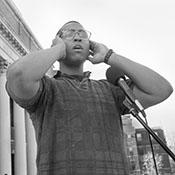 The history of adhan (call to prayer) began with a vision in a dream by one of Prophet Muhammad’s followers and a freed African slave serving as the first muezzin. Adhan calls Muslims around the world to pray five times a day. It can be broadcast around the neighborhood, recited from within the mosque building, or sounded from a sidewalk.
The history of adhan (call to prayer) began with a vision in a dream by one of Prophet Muhammad’s followers and a freed African slave serving as the first muezzin. Adhan calls Muslims around the world to pray five times a day. It can be broadcast around the neighborhood, recited from within the mosque building, or sounded from a sidewalk.
View Full Album
Muslim daily life is punctuated with five ritual prayers, or salat. In the early Muslim community in Medina, according to tradition, faithful Muslims would gather around the Prophet Muhammad without any summons. The Prophet considered using a horn, as did the Jews to call the community to prayers, as well as a wooden gong, as the Eastern Christians did. One of his followers had a vision in a dream, however, in which a man taught him a better way to call people to prayer, saying, in translation:
God is the Greatest! God is the Greatest!
God is the Greatest! God is the Greatest!
I bear witness that there is no god but God.
I bear witness that there is no god but God.
I bear witness that Muhammad is the Messenger of God.
I bear witness that Muhammad is the Messenger of God.
Come to prayer. Come to prayer.
Come to success. Come to success.
God is the Greatest! God is the Greatest!
There is no god but God.
The Prophet confirmed this dream and appointed Bilal, a freed African slave, to be the first muezzin, to use his penetrating voice to sound this call to prayer, the adhan, from the mosque. From this time on, for thirteen centuries, the adhan has called the faithful all over the world to perform their five daily prayers. The adhan is a regular reminder of the submission of all of life for the service of God, and a reminder that life is shaped by prayer.
The adhan is a summons to enter the prayer space, to turn one’s body, mind and spirit toward God. In many predominantly Muslim countries, the call to prayer is broadcast over speakers five times each day from the minaret of each local mosque. In the United States, most Islamic Centers and mosques issue the call from within their buildings to those already gathered for prayer. Others call the adhan publicly before special community gatherings: at the Islamic Center of Toledo, the muezzin climbs the spiral staircase of the minaret and issues the call to prayer across the vast Ohio cornfields.
Some American Muslim communities issue the call to prayer on a regular basis. At Dar al-Islam, the call echoes out over the rugged southwestern landscape of New Mexico; at the Muslim Community Center in downtown San Francisco, the muezzin issues the call from the sidewalk on Divisadero Street. Loudspeakers are used to broadcast the adhan from mosques in many parts of the country, such as Atlanta’s Masjid al-Islam and, in the nation’s capital, from the Islamic Center of Washington, D.C. on Embassy Row.